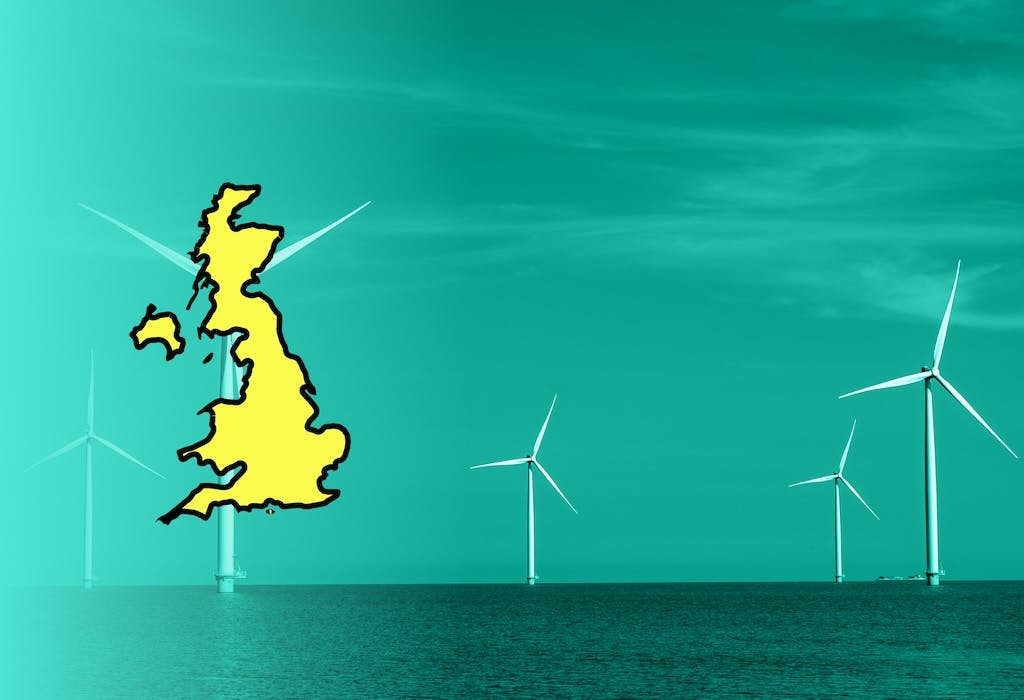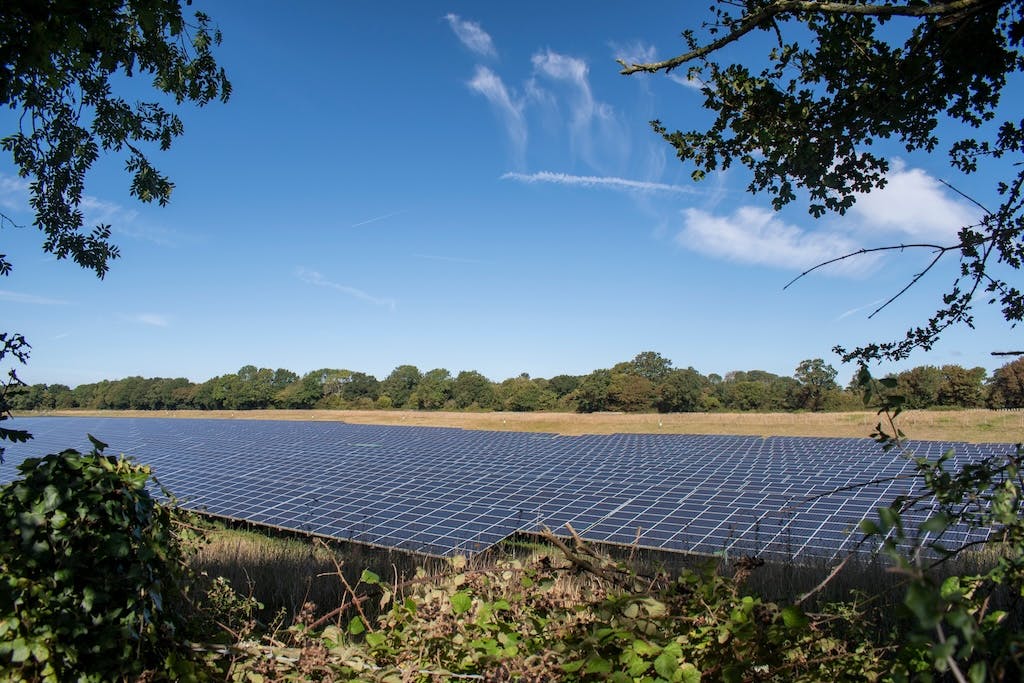How much of the UK’s energy is renewable?
Learn about the contribution of renewable energy to the UK's electricity mix, what the key sources are, and what the future holds.
Written byMelody Abeni

Renewable energy in the UK: at a glance
🇬🇧 Renewables accounted for 51% of the UK’s electricity mix in 2024
🌬️ Wind power was the largest source, contributing 30%
🍃 The second-largest source of renewable electricity was biomass
📈 The government is aiming for 95% of electricity from clean sources by 2030
🤝 The UK has legally committed to achieving net zero by 2050
The UK's race to net zero emissions is on. With the aim to achieve this goal by 2050, using clean energy is a key part of the government's strategy. But how far has the country come, and how much further does it need to go?
This article will dive into the past and current situation, and what it all could mean for the future.
If you’re looking to join the renewable energy revolution and make the switch to solar, answer a few quick questions below, and we’ll provide you with a savings estimate.
How much energy in the UK comes from renewables?
Renewable energy comes from natural sources that replenish over time, like wind, solar, and hydropower. Unlike fossil fuels, these sources produce little to no greenhouse gas emissions and don't deplete, so they're great for the planet.
In recent years, a significant chunk of UK electricity has come from renewables, and in 2024, wind power became the largest single source of electricity generation for the first time, contributing 30% of the total.
Renewables accounted for 51% of the UK’s electricity generation on average across 2024, and it’s also the first time they consistently provided more than half of the country’s electricity over four consecutive quarters (Q4 2023 to Q3 2024).
The UK has set a clear timeline for reaching net zero emissions (more on that below), and using clean electricity is a key part of their strategy. This means relying more on renewables, which are already proving their ability to power the nation sustainably.
What are the government’s energy targets?
The UK has legally committed to achieving net zero emissions by 2050, though Scotland has set itself an even more ambitious target, aiming to get there five years earlier.
The term 'net zero' refers to balancing the amount of greenhouse gases emitted into the atmosphere with the amount removed, effectively reducing emissions to as close to zero as possible.
To hit its target, and follow the National Energy System Operator's (NESO) advice, the government wants green power to meet the vast majority of electricity demand by 2030.
At least 95% of our electricity should come from low-carbon sources, with a maximum limit of 5% for unabated gas - this is gas that's released directly into the air without pollution control.
To have the best chance of meeting the UK’s net zero target, all sectors of the country’s economy must slash their emissions while massively stepping up carbon removal efforts, like reforestation and other carbon capture technologies.

What's the carbon intensity of the national grid?
The UK’s electricity was the cleanest it has ever been in 2024, with the carbon dioxide (CO2) emissions per unit of electricity falling by more than two-thirds over the past decade, according to Carbon Brief analysis.
The dramatic reduction in carbon intensity - from 419gCO2 per kilowatt hour (kWh) in 2014 to just 124gCO2 per kWh in 2024 - reflects the UK’s gradual shift away from fossil fuels, which is largely because of the phase-out of coal.
Today, the UK gets less than half as much electricity from burning fossil fuels as it did a decade ago. At the same time, renewable electricity generation has more than doubled, increasing from 65 terawatt hours (TWh) in 2014 to 143TWh in 2024 - a 122% rise.
The UK's farewell to coal
On 30 September 2024, the Ratcliffe-on-Soar power station shut off for the final time, marking an end to 142 years of coal power in the UK.
As the last operational coal-fired power station in the UK, Ratcliffe had been a symbol of the country’s industrial past. But coal accounted for just 0.6% of electricity generation in 2024, reflecting its near-total phase-out.
Breakdown of the UK's renewable energy sources
The UK’s renewably-generated electricity comes primarily from four sources: wind, solar, hydroelectric, and biomass.
The chart below shows the contribution of different renewable energy sources - as well as all other sources - to the UK’s electricity mix in 2024, based on data from NESO.
The UK's electricity mix in 2024
Wind power stands out as the largest single source, providing 30% of the UK’s electricity in 2024 and even surpassing gas, which accounted for 26.3%.
About 14% of the UK’s electricity currently comes from various European countries, like France, Belgium, Denmark, the Netherlands, and Norway - and a portion of this imported electricity is generated by renewable sources such as wind, solar, and hydroelectric.
Wind power
Share of total UK electricity in 2024: 30%
We make use of the wind's kinetic energy with turbines, installed either on land (onshore) or at sea (offshore). As noted earlier, wind contributed 30% of the UK’s total electricity generation in 2024, making it the country's largest single source of power.
Offshore wind dominates the UK’s wind capacity, with large-scale projects like the Hornsea wind farms in the North Sea leading the way. However, growth in wind power has slowed over the past two years.
The UK added 3.5 gigawatts (GW) of new wind capacity in 2022, but that fell to 1.6GW in 2023 and only 0.7GW in 2024, mostly thanks to Shetland's 0.4GW Viking project. And we didn't get any new offshore wind farms in 2024.
Plus, wind speeds have been lower than usual in most places in Europe for two years now, with October and November 2024 being particularly bad (7% and 22% below average, respectively).
This phenomenon, known as dunkelflaute, shows the challenge associated with relying on wind-generated electricity during calm weather periods.
Main locations
The UK is home to some of the world's largest wind farm projects, both onshore and offshore.
Offshore wind dominates in terms of capacity, with the Hornsea 2 wind farm in the North Sea currently holding the title as the world's largest offshore wind farm. It has a capacity of 1.32GW and generates enough electricity to power over 1.4 million homes annually.
The Viking Wind Farm in Scotland's Shetland Islands is the UK's largest onshore wind farm, with a capacity of 0.44GW, spread across 103 turbines. This is closely followed by Clyde Wind Farm on mainland Scotland, with a capacity of 0.35GW across 152 turbines.
Looking ahead, several major offshore wind farms are under construction and set to open in the coming years.
These include Dogger Bank A (1.2GW), Moray West (0.9GW), and Neart Na Gaoithe (0.5GW), all expected to come online in 2025. By 2026, Dogger Bank B (1.2GW) and Sofia (1.4GW) will further expand the UK’s offshore wind capacity.
With these developments, wind power could well continue to be the UK’s largest source of electricity.
Solar power
Share of total UK electricity in 2024: 5%
Solar photovoltaic (PV) panels convert natural light into electricity regardless of whether it’s sunny or cloudy, making it a practical option for the UK’s often overcast weather.
The UK’s solar energy output continues to grow, with 1.6GW of new capacity installed in 2024. This included several large-scale installations in England, like Larport, at 45 megawatts (MW), and Whirlbush Farm (36MW), as well as Hopkins (28MW) in Wales.
The remaining additional capacity came from small scale installations (i.e. 50 kilowatt-peak or less).

Main locations
The UK is home to several large-scale solar farms that contribute significantly to its renewable electricity generation.
One of the largest is the Llanwern Solar Farm in south-east Wales, which spans three sites and consists of 187,500 solar panels. Another major site is the Shotwick Solar Farm in northern Wales, covering 220 acres and capable of powering over 18,000 homes each year.
Residential solar panels are also becoming increasingly popular; there are now more than 1.5 million homes in the UK with solar panels, helping them reduce their energy bills, earn export income, and cut their carbon footprints.
To learn more, check out our guide to energy bill savings with solar panels.
Wondering how much a solar & battery system could save you? Answer a few simple questions below and we’ll provide an estimate.
Hydroelectric power
Share of total UK electricity in 2024: 2%
Hydroelectric dams use the kinetic energy of flowing water to spin turbines, which in turn generate electricity.
It's one of the oldest forms of renewable energy, with the UK’s first hydroelectric generator installed in 1878 at Cragside House in Northumberland, where it powered a single lamp. Our country’s wet climate and fast-flowing rivers make it very well-suited to hydroelectric technology.
Today, hydroelectric power contributes a small but steady stream of electricity to the UK’s overall mix, through a combination of large-scale plants and micro systems.
Main locations
The UK is home to several hydroelectric power stations, with the largest being the Dinorwig Power Station in Snowdonia, Wales. Dinorwig is a pumped storage hydroelectric facility with a capacity of 1.7GW, making it the largest of its kind in the UK.
Other major hydro projects include Cruachan (0.44GW) in Scotland, first commissioned in 1965, and Ffestiniog Power Station (0.36GW) in Wales, which has been operational since 1963.
The Coire Glas project, currently under development in the Scottish Highlands, is set to become the UK’s largest pumped-storage hydro scheme in 40 years, further boosting our hydroelectric capacity.
Biomass power
Share of total UK electricity in 2024: 6.8%
Biomass power refers to the generation of electricity by burning organic materials like wood, plants, and waste to produce steam, which drives a turbine. In 2024, biomass was the UK’s second-largest source of renewable electricity, generating 40 terawatt hours (TWh) - a 17% increase from 2023.
However, its sustainability is a topic of debate. While the National Grid classes biomass as renewable, concerns about carbon emissions and deforestation have raised questions about its environmental impact.
The UK's largest producer of biomass energy is Drax Power Station in North Yorkshire, a former coal plant converted to burn wood pellets. However, Drax has faced significant criticism, including allegations of burning logs from vital, carbon-rich forests in Canada, as revealed by a BBC Panorama investigation.
Reports have also highlighted that Drax’s emissions can be up to quadruple the amount of those of coal plants, further fuelling the controversy.
Drax accounts for about a third of the electricity produced by biomass in the UK. The rest comes from more sustainable sources, including landfill gas, sewage gas, and anaerobic digestion of organic waste. These alternatives are less controversial and play a vital role in diversifying the UK’s renewable energy mix.
The long-term role of biomass in the UK is uncertain, with the government announcing in February 2025 that it would be cutting funding in half for Drax.
Main locations
The UK is home to several significant biomass power plants, with the largest being the aforementioned Drax Power Station (2.58GW). The Lynemouth Power Station in Northumberland (0.42GW) is also a key site, dedicated entirely to biomass electricity generation.
Another major facility was the converted Ironbridge Power Station, but this closed down at the end of 2015. At the time of its closure, the plant was the world's largest biomass power plant with an installed capacity of 0.74GW.
Growth of renewable energy in the UK over time
The UK’s transition to renewable energy has been remarkable. In 1920, just 0.3% of electricity came from renewable sources, while coal dominated with a mighty 97%, and oil made up 2.7%.
The shift started much later, and it began slowly. The UK's first wind farm came online in November 1991 at Delabole in Cornwall, marking the start of wind energy’s contribution to the grid. Solar followed a few decades after, with the first solar farm built in 2011, also in Cornwall.
For decades, renewable energy was just a minor part of the energy mix, only reaching 6% of electricity generation in 2011 - but its growth accelerated from there.
Renewables accounted for 16% of electricity in 2015, 25.1% in 2019, and then 34.8% in 2023. But by 2024, renewables made up a staggering 51% of the UK’s electricity generation, surpassing fossil fuels for the first time.
Investments in solar, wind, and other technologies, alongside supportive government policies (like the Smart Export Guarantee and ECO4), are speeding up the shift towards a low-carbon energy system.
What's the future for renewable energy in the UK?
Renewable energy in the UK has grown rapidly in recent years, consistently breaking records to become the backbone of the grid. And experts expect its share of the country’s electricity generation to climb even higher in the coming years.
Offshore wind is leading this expansion, with major projects like Dogger Bank set to significantly boost capacity. Solar is also booming, driven by large-scale installations and a growing number of households adopting rooftop panels.
This growth couldn’t be more urgent. The UK’s reliance on imported natural gas has heavily contributed to recent energy price cap increases, which highlights the need for cleaner, more affordable energy sources.
If you’re curious about how much a solar & battery system could save you, answer a few quick questions below and we’ll provide you with an estimate.
Renewable energy in the UK: FAQs
What percentage of UK electricity will be renewable in 2030?
In 2030, the UK is planning to generate 95% of its electricity with renewable sources, in line with its 2050 net zero targets.
Meanwhile, the use of Britain’s fleet of gas power stations will be reduced to “no more than 5% of total generation”, according to the government’s Clean Power 2030 Action Plan.
Which country has 100% green energy?
Several countries generate 100% of their electricity with renewable sources, including Iceland, Paraguay, Bhutan, and Albania.
These nations rely on a mix of hydropower, geothermal, wind, and solar energy, making full use of their respective natural resources.
What is the world's largest source of renewable energy?
According to the International Energy Agency (IEA), biomass is the world’s largest source of renewable energy, accounting for just under 55% of global renewable electricity generation.

Written byMelody Abeni
Based in London, Melody is a specialist green technology writer who has been covering sustainability, climate action and ESG for the past five years, after gathering operational experience in green investing and financial services. She has written for various industry publications, including renewable technology advisor The Eco Experts, and she holds a Master’s degree in law from Birkbeck University.